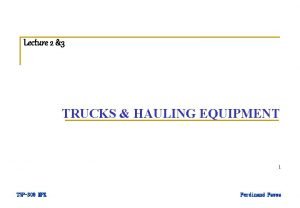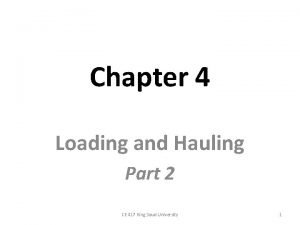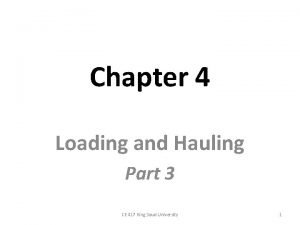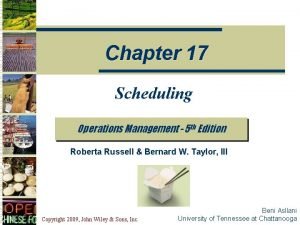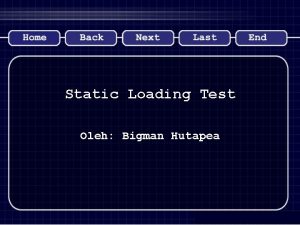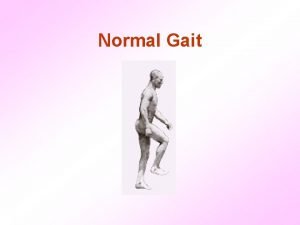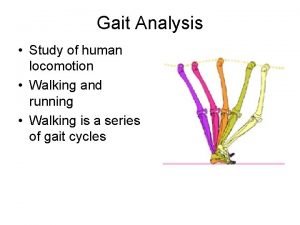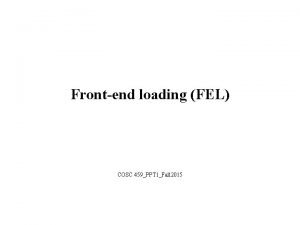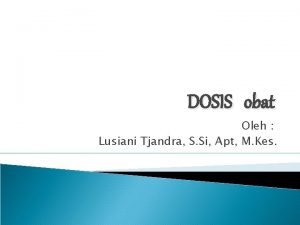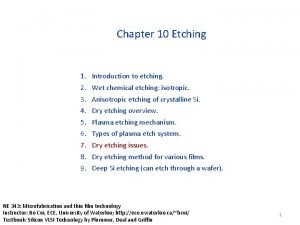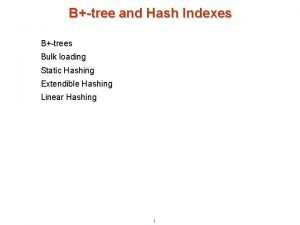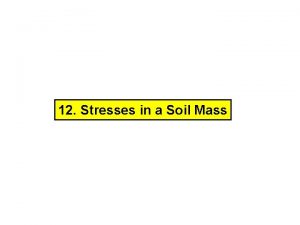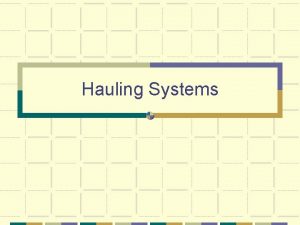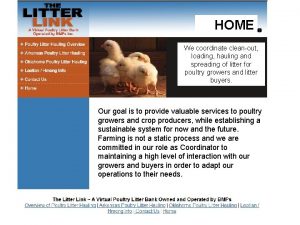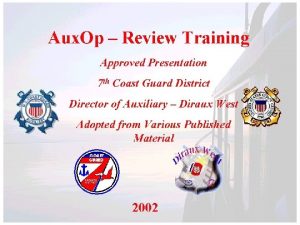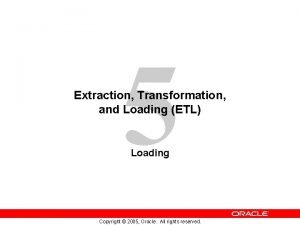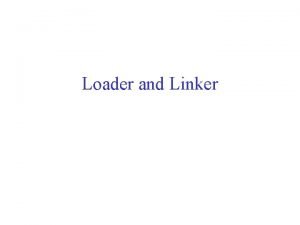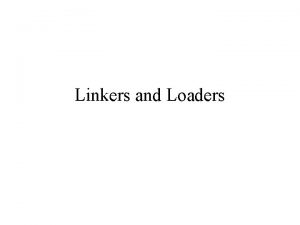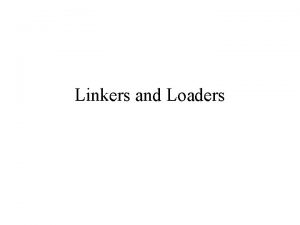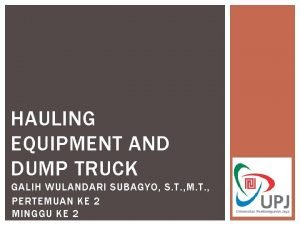Chapter 4 Loading and Hauling Part 2 CE













































- Slides: 45

Chapter 4 Loading and Hauling Part 2 CE 417 King Saud University 1

4 -2 DOZERS • This section includes: – Tractors and Dozers – Dozer Blades – Estimating Dozer Production – Job Management CE 417 King Saud University 2

Tractors and Dozers • A tractor equipped with a front-mounted earthmoving blade is known as a dozer or bulldozer. • A dozer moves earth: – by lowering the blade and cutting until a full blade load of material is obtained. – It then pushes the material across the ground surface to the required location. CE 417 King Saud University 3

Tractors and Dozers • Both rubber-tired (or wheel) dozers and crawler (or track) dozers are available. – Because of their excellent traction and low ground pressure (typically 6 to 9 lb/sq in. ; 0. 4 to 0. 6 bar), crawler dozers (Figure 4 -6) are well suited for use in rough terrain or areas of low trafficability – Low-ground-pressure models with extra-wide tracks are available having ground pressures as low as 3 lb/sq in. (0. 2 bar). CE 417 King Saud University 4

FIGURE 4 -6: Crawler tractor dozer. (Courtesy of Fiatallis North America, Inc. ) CE 417 King Saud University 5

Tractors and Dozers – Crawler dozers can operate on steeper side slopes and climb greater grades than can wheel dozers. – Wheel dozers can operate at higher speed than do crawler dozers. – Wheel dozers are also capable of operating on paved roads without damaging the surface. • Crawler dozers cause damage. – While the wheel tractor's dozing ability is limited somewhat by its lower traction and high ground pressure (25 to 35 lb/sq in. ; 1. 7 to 2. 4 bars), its high ground pressure makes it an effective soil compactor. CE 417 King Saud University 6

Tractors and Dozers • Either rubber-tired or crawler tractors may be equipped with attachments other than dozer blades. • These include rakes used for gathering up brush and small fallen trees, and plows, rippers, and scarifiers, which are used to break up hard surfaces. • Tractors are also used to tow many items of construction equipment, such as: – compactors, – scrapers, and – wagons. CE 417 King Saud University 7

Tractors and Dozers • Dozers may be equipped with: – direct-drive, – power-shift, or – hydrostatic transmissions. • Hydrostatic transmissions utilize individual hydraulic motors to drive each track. Therefore, – the speed of each track may be infinitely varied, forward or reverse. – it is possible for a dozer equipped with a hydrostatic drive to turn in its own length by moving one track forward while the other track moves in reverse. CE 417 King Saud University 8

Dozer Blades • There a number of types of dozer blades available, and the four most common types are illustrated in Figure 4 -7. • The three types of adjustments that maybe made to dozer blades are illustrated in Figure 4 -8. • Tilting the blade is useful for ditching and breaking up frozen or crusty soils. – Pitching the blade forward reduces blade penetration and causes the loosened material to roll in front of the blade, – whereas pitching the blade backward increases penetration. CE 417 King Saud University 9

Figure 4 -7: Common types of dozer blades CE 417 King Saud University 10

Dozer Blades • Angling the blade is helpful in 3 purposes: – side-hill cutting, – ditching, and – moving material laterally. • All the blades shown in Figure 4 -7 may be tilted except the cushion blade. • However, only the angle blade may be angled. CE 417 King Saud University 11

Dozer Blades FIGURE 4 -8: Dozer blade adjustments. CE 417 King Saud University 12

Dozer Blades • The two indicators of potential dozer performance are based on the ratio of tractor power to blade size • These indicators are : – horsepower per foot of cutting edge: provides a measure of the blade's ability to penetrate hard soils and – horsepower per loose cubic yard rating: provides an indication of the blade's ability to push material once the blade is loaded. . CE 417 King Saud University 13

Dozer Blades • The wings on the universal blade (Figure 4 -7) enable it to push a large volume of material over long distances. – However, its low horsepower per foot of cutting edge and per cubic yard limit its ability to penetrate hard soils or to move heavy materials. • The straight blade is considered the most versatile dozer blade. – Its smaller size gives it good penetrating and load pushing ability. CE 417 King Saud University 14

Dozer Blades • Angle Blades – Have the ability of angle blades to angle approximately 25° to either side makes them very effective in: • side hill cutting, • ditching, and • backfilling. – They may also be used for rough grading and for moving material laterally. CE 417 King Saud University 15

Dozer Blades • The cushion blade : – is reinforced and equipped with shock absorbers to enable it to push-load scrapers. – It may also be used for cleanup of the loading or dumping areas and for general dozing when not push-loading scrapers. CE 417 King Saud University 16

Dozer Blades • Other available types of dozer blades include: – light-material U-blades, – special clearing blades, and – rip dozer blades (blades equipped with ripper shanks on each end). CE 417 King Saud University 17

Estimating Dozer Production • The basic earthmoving production equation (Equation 2 -1) may be applied in estimating dozer production. – This method requires an estimate of the average blade load and the dozer cycle time. • There are several methods available for estimating average blade load, including: – the blade manufacturer's capacity rating, – previous experience under similar conditions, and – actual measurement of several typical loads. CE 417 King Saud University 18

Estimating Dozer Production • A suggested method for calculating blade volume by measuring blade load is as follows: – Doze a full blade load, then lift the blade while moving forward on a – level surface until an even pile is formed. – Measure the width of the pile (W) perpendicular to the blade and in line with the inside of each track or wheel. Average the two measurements. CE 417 King Saud University 19

Estimating Dozer Production – Measure the height (H) of the pile in a similar manner. – Measure the length of the pile parallel to the blade. – Calculate blade volume using Equation 4 -10. • Blade load (LCY) = 0. 0139 × H (ft) × W(ft) × L (ft) • Blade load (LCM) = 0. 375 × H (m) × W (m) × L (m) CE 417 King Saud University 20

Estimating Dozer Production • Total dozer cycle time is the sum of its: – fixed cycle time and – variable cycle time. • Fixed cycle time (Table 4 -4 ) represents the time required to: – maneuver, – change gears, – start loading, and – dump. CE 417 King Saud University 21

TABLE 4 -4: Typical dozer fixed cycle times CE 417 King Saud University 22

Estimating Dozer Production • Variable cycle time is the time required to doze and return (Table 4 -5 ). – Since the haul distance is relatively short, a dozer usually returns in reverse gear. – Some manufacturers provide dozer production estimating charts for their equipment. CE 417 King Saud University 23

TABLE 4 -5: Typical dozer operating speeds CE 417 King Saud University 24

EXAMPLE 4 -6 • Estimate the production of the dozer that has the following information: – A power-shift crawler tractor has a rated blade capacity of 10 LCY (7. 65 LCM). – The dozer is excavating loose common earth and pushing it a distance of 200 ft (61 m). – Maximum reverse speed in third range is 5 mi/h (8 km/h). – job efficiency is 50 min/h. CE 417 King Saud University 25

EXAMPLE 4 -6 Solution Fixed time =0. 05 min Dozing speed =2. 5 mi/h (4. 0 km/h) Dozing time = 200/(2. 5 × 88) = 0. 91 min [ = 61/(4 × 16. 7) = 0. 91 min] (Table 4 -4) (Table 4 -5) Note: 1 mi/h=88 ft/min; 1 km/h =16. 7 m/min. Return time = 200/(5× 88) =0. 45 min [ = 61/(8 × 16. 7) = 0. 45 min] Cycle time = 0. 05+ 0. 91+ 0. 45= 1. 41 min Production= 10 × 50/1. 41= 355 LCY/h [ = 7. 65 × 50/1. 41= 271 LCM/h] CE 417 King Saud University 26

Job Management • Some techniques used to increase dozer production include: – downhill dozing, – slot dozing, and – blade-to-blade dozing. • By taking advantage of the force of gravity, downhill dozing enables blade load to be increased or cycle time to be reduced compared to dozing on the level. CE 417 King Saud University 27

Job Management • Slot dozing utilizes a shallow trench (or slot) cut between the loading and dumping areas to increase the blade capacity that can be carried on each cycle. – Under favorable conditions, slot dozing may increase dozer production as much as 50%. CE 417 King Saud University 28

Job Management • Blade-to-blade dozing involves two dozers operating together with their blades almost touching. – This technique results in a combined blade capacity considerably greater than that of two single blades. – However, the technique is not efficient for use over short dozing distances because of the extra maneuvering time required. • Mechanically coupled side by-side (S × S) dozers equipped with a single large blade are available and are more productive than are blade-to-blade dozers. CE 417 King Saud University 29

4 -3 LOADERS • A tractor equipped with a front-end bucket is called a loader, front-end loader, or bucket loader. • Both wheel loaders (Figure 4 -9) and track loaders (Figure 4 -10) are available. CE 417 King Saud University 30

FIGURE 4 -9: Articulated wheel loader with articulated hauler. (Courtesy of Volvo Construction Equipment North America, Inc. ) CE 417 King Saud University 31

FIGURE 4 -10: Track loader. (Courtesy of John Deere Construction & Forestry Company) CE 417 King Saud University 32

4 -3 LOADERS • Loaders are used for: – excavating soft to medium-hard material, – loading hoppers and haul units, – stockpiling material, – backfilling ditches, and – moving concrete and other construction materials. CE 417 King Saud University 33

4 -3 LOADERS • Wheel loaders : – possess excellent job mobility and are capable of overthe road movement between jobs at speeds of 25 mi/h or higher. – While their ground pressure is relatively low and may be varied by the use of different size tires and by changing inflation pressures, they do not have the allterrain capability of track loaders. – Most modern wheel loaders are articulated. • That is, they are hinged between the front and rear axles to provide greater maneuverability. CE 417 King Saud University 34

4 -3 LOADERS • Track loaders : – are capable of overcoming steeper grades and side slopes than are wheel loaders. – Their low ground pressure and high tractive effort enable them to operate in all but the lowest trafficability soils. – Because of their lower speed, their production is less than that of a wheel loader over longer haul distances. CE 417 King Saud University 35

Estimating Loader Production • Loader production may be estimated as the product of average bucket load multiplied by cycles per hour (Equation 2 -1). • Basic cycle time for a loader, wheel or track loader, (Table 4 -6) includes the time required for loading, dumping, making four reversals of direction, and traveling a minimum distance (15 ft or less for track loaders). • Typical travel-time curves for wheel loaders are presented in Figure 4 -15. – While manufacturers' performance curves should be used whenever possible. CE 417 King Saud University 36

TABLE 4 -6: Basic loader cycle time CE 417 King Saud University 37

FIGURE 4 -15: Travel time, wheel loader (haul + return). CE 417 King Saud University 38

Estimating Loader Production • Federal Highway Administration (FHWA) studies have shown little variation in basic cycle time for wheel loaders up to a distance of 80 ft (25 m) between loading and dumping position. – Therefore, travel time should not be added until oneway distance exceeds this distance. • Loader bucket capacity is rated in heaped (loose) volume, as shown in Table 3 -1. – Bucket capacity should be adjusted by a bucket fill factor (Table 3 -2) to obtain the best estimate of actual bucket volume. CE 417 King Saud University 39

EXAMPLE 4 -7 • Estimate the hourly production in loose volume (LCY and LCM) of : – a 3 1/2 -yd (2. 68 -m 3) wheel loader excavating sand gravel (average material) from a pit and moving it to a stockpile. – The average haul distance is 200 ft (61 m), – the effective grade is 6%, – the bucket fill factor is 1. 00, and – job efficiency is 50 min/h. CE 417 King Saud University 40

EXAMPLE 4 -7 • Solution Bucket volume =3. 5 × 1 =3. 5 LCY (2. 68 LCM) Basic cycle time = 0. 50 min (Table 4 -6) Travel time =0. 30 min (Figure 4 -14) Cycle time =0. 50 + 0. 30 =0. 80 min Production = 3. 5 × 50/0. 80 =219 LCY/h [ =2. 68 × 50/0. 80 =168 LCM/h] CE 417 King Saud University 41

Job Management • Cutting of tires is a major problem when loading shot rock with a wheel loader. • Type L-5 tires (rock, extra deep tread) should be used to increase tire life when loading rock. CE 417 King Saud University 42

Job Management • In selection of a loader, consideration must also be given to the following: – (1) the weight of the material being handled may limit the size of the bucket that may be used on a loader. • Because of tipping load limitations, – (2) clearances required during loading and dumping. – (3) optimum positioning of the loader and haul units • to minimize loading, maneuver, and dump times. CE 417 King Saud University 43

Job Management • Multisegment buckets, also called 4 -in-1 buckets and multipurpose buckets (Figure 4 -16), are capable of performing as a clamshell, dozer, or scraper, as well as a conventional loader. – Such buckets are often more effective than are conventional buckets in handling wet, sticky materials. • Blasting or ripping hard materials before attempting to load them will often increase loader production in such materials. CE 417 King Saud University 44

Figure 4 -16: Multisegment loader bucket. CE 417 King Saud University 45
 Factors affecting haulers productivity
Factors affecting haulers productivity Loading and hauling
Loading and hauling Hauling part
Hauling part Java dynamic class loading
Java dynamic class loading Perbedaan granit double loading dan single loading
Perbedaan granit double loading dan single loading Waste management (now wm) - wichita hauling
Waste management (now wm) - wichita hauling Health and safety of injection moulding
Health and safety of injection moulding Loading sequencing and scheduling
Loading sequencing and scheduling Azure sql data warehouse smp
Azure sql data warehouse smp Static vs dynamic linking
Static vs dynamic linking Part part whole addition
Part part whole addition Unit ratio definition
Unit ratio definition Part part whole
Part part whole Technical object description example
Technical object description example Under bar equipment layout
Under bar equipment layout The phase of the moon you see depends on ______.
The phase of the moon you see depends on ______. Two way anova minitab 17
Two way anova minitab 17 Depericarper meaning
Depericarper meaning Bigman hutapea
Bigman hutapea Advantage of size separation
Advantage of size separation Skl tm
Skl tm Dark room radiographic darkroom layout
Dark room radiographic darkroom layout Rumus dosis obat
Rumus dosis obat Tcrm navy steps
Tcrm navy steps Prerequisites of gait
Prerequisites of gait Nmos inverter
Nmos inverter Ivpb medication
Ivpb medication Glycomet
Glycomet Site:slidetodoc.com
Site:slidetodoc.com Loading response gait
Loading response gait Front end loading
Front end loading Forward vs backward scheduling
Forward vs backward scheduling Loading dose units
Loading dose units Loading dose units
Loading dose units Java create class dynamically
Java create class dynamically Sacch lactis q.s
Sacch lactis q.s Loading dose example
Loading dose example Reem alzahrani
Reem alzahrani Loading dose formula
Loading dose formula Etch rate
Etch rate B+ tree bulk loading
B+ tree bulk loading Vertical
Vertical Residential floor loading
Residential floor loading Load register
Load register Loading dose example
Loading dose example Loading please wait artinya
Loading please wait artinya
